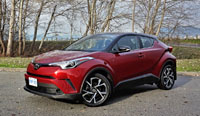
During the introduction of the FT-1 concept at the 2014 Detroit auto show, Toyota president Akio Toyoda issued a companywide decree for “no more boring cars,” and this C-HR is a direct result of this type of thinking, at least with respect to styling. Do you think it embodies Toyoda’s hopes for a level of “style that stirs peoples’ emotions and makes them say ‘I want to drive this’?”
Toyoda obviously does, as he would’ve approved the initial design and given the go-ahead for this production model. Being just 63, he’s still very much in charge of his grandfather’s car company, and I must say the namesake Japanese brand’s newest SUV is just one of many dynamic designs to arrive on the scene in recent years.
I won’t comment on CH-R styling in detail, first because my taste isn’t your taste, and secondly because I’m a fan of unorthodox designs like Nissan’s Juke and Cube, as long as the proportions are right and there’s some sort of balance to the overall look. The CH-R fits nicely into that category, pushing the limits in some respects, but probably acceptable enough to the masses to maintain reasonable resale values.
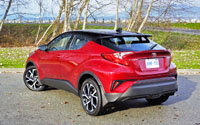
It’s more important that Toyota finally has something to compete in this subcompact SUV class, and I give them high marks for courage, being that the majority of rivals already enjoying success here did so by focusing more on things practical than eye-catching design. It was as surprise that Toyota showed up with this sportier looking, slightly smaller than average alternative that seems to put style ahead of pragmatism.
A rundown of class sales leaders shows that passenger and cargo spaciousness and flexibility rules the roost, with long-term top-sellers include the innovative Honda HR-V, funky yet practical Kia Soul, and larger than average Subaru Crosstrek, while a couple of newcomers doing well include the cheap and sizeable Nissan Qashqai, as well as the all-round impressive Hyundai Kona. It’s like this new C-HR said hello to the same type of buyers that were lamenting the loss of the recently cancelled Juke (replaced by the new Kicks), although missing the AWD Juke’s stellar performance. Go-fast goodness may also help propel Canadian sales of the Mazda CX-3, not to mention its arguably stylish design.
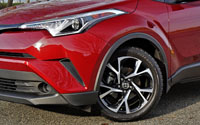
This is model-year two for the new C-HR, and all things considered it’s a commendable subcompact crossover SUV. My test model was tarted up in new Limited trim, which reaches higher up the desirability scale than last year’s XLE, which I tested and reviewed last year. Altogether I’ve tested three C-HR’s, and each provided impressive comfort with the same level of features as comparatively priced competitors, plus amply capable performance, and superb fuel efficiency.
One of the C-HR’s strengths is interior refinement, although I wouldn’t say it’s the segment’s best when compared to the previously noted CX-3 in its top-tier GT trim, which gets very close to the luxury subcompact SUV class, and that’s even when comparing Mazda’s best to this top-level Limited model. I did like the C-HR Limited’s nicely detailed padded, stitched leatherette dash-top, plus the large padded bolster just underneath that stretches from the right side of the instrument panel to the front passenger’s door, while a smaller padded section adorns the left side of the primary gauge package. Each door upper receives the same premium-level soft touch synthetic surface treatment, while all armrests get an even softer, more comfortable covering.
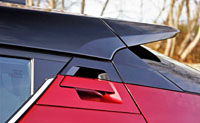
Those who thrill at the sight of plentiful piano black lacquered plastic will be overjoyed with all of the dark shiny trim strewn around Toyota’s smallest crossover. I’d personally like it if there were less, and not due to its addition to interior design, but instead because it attracts dust something awful and scratches way too easily. I like the diamond-textured hard plastic on door inserts and lower panels, however, which are truly unique, look great and feel durable enough to last the test of time. It certainly doesn’t feel as cheap as the usual hard plastic found in these areas in this segment, plus the diamond pattern complements the unusual assortment of diamond-shaped reliefs stamped into the overhead roofliner.
Before I take a deep dive into the C-HR’s interior design and quality, I should mention this 2019 model received a few upgrades that should allow it to find more buyers while improving it overall compared to last year’s version, starting with a new base LE trim that eliminates more than $1,000 from the 2018 C-HR’s base window sticker. This said $23,675 isn’t as approachable as some competitors noted earlier in this review, the Qashqai now available from $20,198 (just $200 more than last year’s version despite plenty of new equipment), and the new Nissan Kicks starting at a mere $17,998, thus making it the most affordable SUV in Canada. Nevertheless, the C-HR’s list of standard goodies is hard to beat, so stay tuned in if you’d like to learn more.
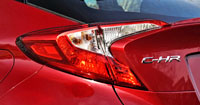
Something else going against this new C-HR’s success is the significantly larger and much more accommodating Nissan Rogue that only costs $3k or so more, while the completely redesigned 2019 RAV4 begins at just $27,790 (check out all the latest pricing details for all makes and models including this C-HR, the Rogue and RAV4 right here at CarCostCanada, with additional info on trims, packages and available options, plus otherwise difficult to get rebate info and dealer invoice pricing that could save you thousands).
A positive for this 2019 C-HR LE is Toyota’s new Entune 3.0 infotainment system that now comes standard across the line. It features a much larger 8.0-inch touchscreen and supports Apple CarPlay smartphone integration, plus Toyota’s superb in-house smartphone integration app. I like this infotainment system a lot, and I like Toyota’s Entune smartphone app even more than Android Auto, no matter whether I’m setting my drive route up in my house via my Samsung S9, or controlling it via the C-HR’s touchscreen. The new display also features a standard backup camera, which might not sound like much of big deal unless you had previously been forced to live with last year’s ultra-small rearview mirror-mounted monitor. Now it’s much easier to use and of course safer thanks to the larger display.

The route guidance mentioned a moment ago comes via a Scout GPS app downloadable from your smartphone’s online store. Like I said, you can set it up before going out via your phone, and then when hooked up to your C-HR it displays your route on the touchscreen just like a regular navigation system. I found it easy to use and extremely accurate, while Toyota also supplies the Entune App Suite Connect with a bundle of applications for traffic, weather, Slacker, Yelp, sports, stocks, fuel and NPR One (a U.S.-sourced public radio station).
The base C-HR LE also receives standard automatic high beam headlamps, adaptive cruise control, remote entry, an acoustic glass windshield, auto up/down power windows all-round, a leather-clad shift knob, a 4.2-inch TFT multi-information display within the primary gauge package, an auto-dimming interior mirror, illuminated vanity mirrors, two-zone automatic climate control, a six-speaker audio system, the aforementioned piano black lacquered trim, fabric seat upholstery, front sport seats, 60/40-split rear seatbacks, a cargo cover, autonomous emergency braking with pedestrian detection, lane departure alert with steering assist, all the expected active and passive safety features plus a few unexpected ones like a driver’s knee airbag and rear side thorax airbags, etcetera, which is downright generous for the base trim level of a subcompact crossover SUV, and therefore should relieve those concerned about its base price being too high.

Last year the C-HR was only available in XLE trim, so it’s good that Toyota kept this model as a mid-range entry while it expanded the lineup with two more trims. The XLE now starts at $25,725 thanks to the new Entune 3.0 Audio Plus system, plus it also includes automatic collision notification, a stolen vehicle locator, an emergency assistance SOS button, and enhanced roadside assistance to enhance its safety equipment, plus 17-inch alloys, a leather-wrapped steering wheel, nicer cloth upholstery, heated front seats (which should really be standard in Canada), and two-way power lumbar support for the driver’s seat.
On top of this you can add on an XLE Premium package that increases the price to $27,325 yet includes larger 18-inch rims, proximity keyless entry with pushbutton start/stop, heated power-retractable outside mirrors with puddle lamps, blindspot monitoring, rear cross traffic alert, and lane change assist.
Lastly, new top-tier Limited trim starts at $28,775 and adds rain-sensing wipers, a very helpful windshield wiper de-icer (especially considering the frigid winter and spring most of us endured this year and last), ambient interior lighting, and attractive textured leather upholstery in either black or brown.
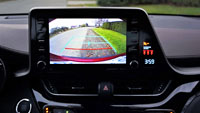
Look under the hood and you’ll something that hasn’t changed for 2019, a 2.0-litre four-cylinder engine that might cause some potential buyers to feel as if the C-HR’s performance doesn’t quite reach up to meet its sporty styling. The engine puts out a reasonable 144 horsepower and 139 lb-ft of torque, which isn’t bad on its own, but the only gearbox it comes mated to is the belt-and-pulley-inspired continuously variable type, a.k.a. CVT, which makes a difference at the pump, but isn’t exactly designed to thrill off the line. What’s more, the C-HR is a front-wheel-drive-only offering, making it the type of SUV you’ll be forced to chain up when hitting the slopes if your local mountain(s) have a policy that requires chains on all vehicles without AWD.
Still, as noted it’s a thrifty little ute, capable of just 8.7 L/100km in the city, 7.5 on the highway and 8.2 combined according to the powers that be at Transport Canada, which thanks to new carbon taxes and other interprovincial and geopolitical issues is critical these days.
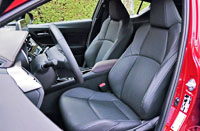
Also important, the C-HR’s wide footprint and low roofline make it reasonably well balanced, which results in handling that nearly adheres to Mr. Toyoda’s “no more boring cars” credo. Nearly is the deciding word, however, as the C-HR is no CX-3 or Kona, but its fully independent MacPherson strut front and double-wishbone/trailing arm rear suspension is plenty of fun when quickly slaloming through a twisting backcountry two-laner or hightailing through town, plus I found its ride quality amongst the segment’s best.
While we’re on the subject of comfort, the C-HR’s front seats are excellent, and its driving position is a considerable improvement over some other Toyota models. To be clear, I have longer legs than torso, which means that I’m required to shove my driver’s seat more towards the rear than most others measuring five-foot-eight, and then adjust the steering column as far rearward as possible. A number of Toyota models simply don’t provide enough steering wheel reach to comfortably allow me a good, safe grip of the wheel with my arms appropriately bent, so I was thrilled the C-HR does.
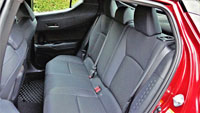
How about rear roominess and comfort. Even after pushing my driver’s seat as far rearward as necessary for my gangly legs, there was approximately four inches left over ahead of my knees when seated directly behind, plus about three inches over my head, which should be good enough for the majority of tallish passengers. I also had ample side-to-side space, although three abreast might feel a bit crowded.
Oddly there isn’t flip-down armrest between the two outboard rear positions, and while not quite as comfortable I’m glad Toyota remembered to include a cupholder just ahead of the armrest on each rear door panel. Also good, the rear outboard seats are comfortable and supportive, especially against the lower back. On the negative, rear seat visibility out the side windows is horrible due to the C-HR’s strangely shaped doors that cause rear occupants to look directly into a big black panel when trying to see out. I’m guessing that kids big and small won’t appreciate this, so make sure you bring the young’uns along for the test drive before you buy.
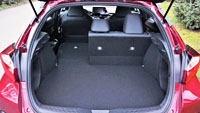
Cargo capacity might also be a deal-breaker for those who regularly haul a lot of life’s gear, because the C-HR’s sporty rear roofline slices into its vertical volume. The result is a mere 538 litres (19.0 cubic feet) of maximum luggage space aft of the rear seatbacks, which is a bit tight when put up against the class leaders. Folding the C-HR’s 60/40-split rear seats flat improves on available cargo space with 1,031 litres (36.4 cu ft), although once again this doesn’t come close to the largest in this segment.
Rather than leave this review on a negative note, I’ll make a point of highlighting the C-HR’s impressive five-star NHTSA safety rating, and should also bring attention to Toyota’s excellent reliability record on the whole. I’m sure such talk isn’t what Toyoda-san would want me relating when wrapping up a review of such a non-boring design exercise, but in truth the C-HR is more about comfort, convenience, economy and dependability than go-fast performance, and while this might seem a bit dull and wholly Toyota-like, it’s also why so many Canadian consumers go back to the world’s most successful Japanese automaker time and time again. For this reason I’d difficult for me to argue against the new C-HR, so if this new subcompact SUV’s styling, size and drivability work for you, by all means take one home.
Story credit: Trevor Hofmann
Photo credit: Karen Tuggay
